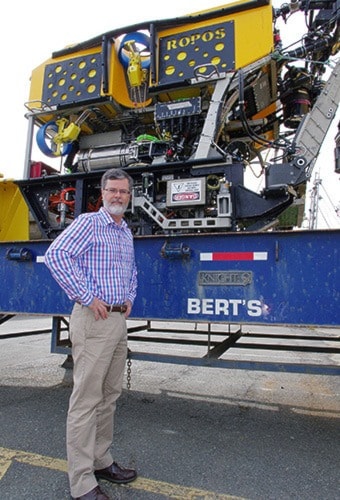Scientists still cannot predict when the next big earthquake will occur, but new equipment being placed at the bottom of the sea this week could give Vancouver Island more than a minute of early warning.
The University of Victoria’s Ocean Networks Canada, which operates the NEPTUNE and VENUS cabled ocean observatories, has sent an expedition 300 kilometers west of Victoria. Researchers plan to perform maintenance and support research at the Cascadia Basin and Endeavour and Clayoquot Slopes. Part of the mission, says Adrian Round, expedition leader, will be to place seismic instruments on the Juan de Fuca plate.
“We’re putting sensors down there to enable us to detect P-wave events,” said Round, who is also ONC’s director of observatory operations.
P-waves, he explained, occur before the arrival of the more destructive S-waves created by an upthrust movement of tectonic plates. The new instruments being placed, Round said, will be able to detect the early indications of an earthquake. They can relay a warning between 30 to 90 seconds before the shock wave actually hits.
What can be done in 30 to 90 seconds? Round said that is enough time for people to shut off gas lines and other vital infrastructure, such as sewage pipes.
“This voyage will be to put the first of those seismic sensors down there.”
Already, the ocean observatories monitored by UVic researchers and scientists around the world, has equipment that can detect tsunamis — part of a global catastrophe monitoring system — as well as water and sediment conditions in the event of a quake.
To get that equipment up to 2.6 kilometers under the ocean, Round said they have leased the ROPOS remote underwater vehicle (ROV) from the Canadian Scientific Submersible Facility. Operators will join scientists on board the Canadian Coast Guard vessel John P. Tully until May 27, where they will be conducting dive missions 24 hours a day.
Round said since this is one of the only times of the year that researchers can get out to the deep sea sites, they must make the most of every minute they have.
To that end, the expedition will conduct experiments, collect data from the ocean floor and replace equipment that needs maintenance. Specialized equipment like the ROV is needed to do that, Round explained, to withstand the immense pressures at such a depth.
The ROV mounts a series of lights (Round says after about 50 meters, there is little to no light in the ocean) and cameras. This enables operators to see what they’re doing and provides a unique opportunity for everyone else back on land.
Coming with the crew, mounted on board the John P. Tully, is a large satellite dish. This, as well as heavy-duty fiber optic cables, will allow the undersea activity to be streamed live online.
The dish, says Virginia Keast, media relations for ONC, will provide high bandwidth video, data and voice service.
Not only will it enable 24/7 ship-to-shore communication, Keast added it will enable scientists around the world to check data and see what’s happening in real time.
This also means anyone can watch the ROV in action online. People can do so by visiting www.oceannetworks.ca and clinking on the live video link.
People will be able to see the ROV deliver equipment to the ocean floor observatory sites and perform maintenance tasks. Keast warns people, however, that is can take up to two hours for the ROV to descend, so they may wish to time their viewing hours.
Once down there, places like the Endeavour hydrothermal vents offer unique views.
“These hot vents are unique from a world perspective,” Round said. “They’re not as viewed as they are here.”
The vents have created an ecosystem like no other and Round said they have to be careful with how much light exposure and activity they do there.
Sea life, such as tube worms and crab, are not used to light at all. Human impact is monitored even so far down.
Loaded with crates of instruments, computer monitors, testing material and more, the John P. Tully is expected to return to the jetty at the Institute of Ocean Sciences in North Saanich on May 27. The expedition, said Round, will keep the entire crew busy around the clock.
“There’s no shortage of things to do.”
editor@peninsulanewsreview.com
